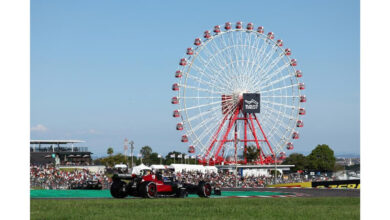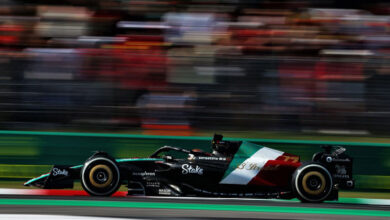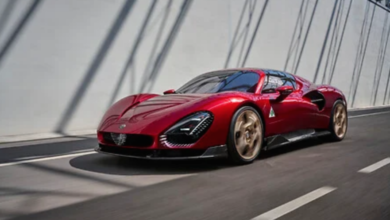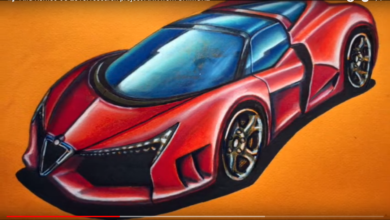The Stellantis Heritage department stars at Padua “Auto e Moto d’epoca” motor show
Over three decades after its first appearance, the Padua Classic Car and Motorcycle Show is rightfully considered one of the major European events in the sector. The Stellantis Heritage department is playing a leading role in the event, with a world-class stand Six prestigious classic cars will be on display, in a layout designed specifically for the occasion: Abarth 750 Record (1956), Abarth 1000 SP (1966), Alfa Romeo Alfetta (1974), Alfa Romeo S.Z. (1989), Lancia Aurelia B20 GT (1951) and Lancia Delta HF Integrale (1994) These vintage gems will be joined by the world première of the current Abarth Classiche 1000 SP - the 2009 project inspired by the 1966 namesake sports car - a rarity brought back to life by Heritage, with only five units on sale. The Padua Motor Show will also serve as an opportunity to reaffirm the fundamental mission of the Stellantis Heritage department, the aim of which is to retrieve, safeguard and leverage the historical heritage of the Alfa Romeo, Fiat, Lancia and Abarth brands. Its objective has recently been emboldened by the first guided tours at the Heritage Hub in Turin, housing around 300 cars that form part of the historical collection owned by Stellantis.
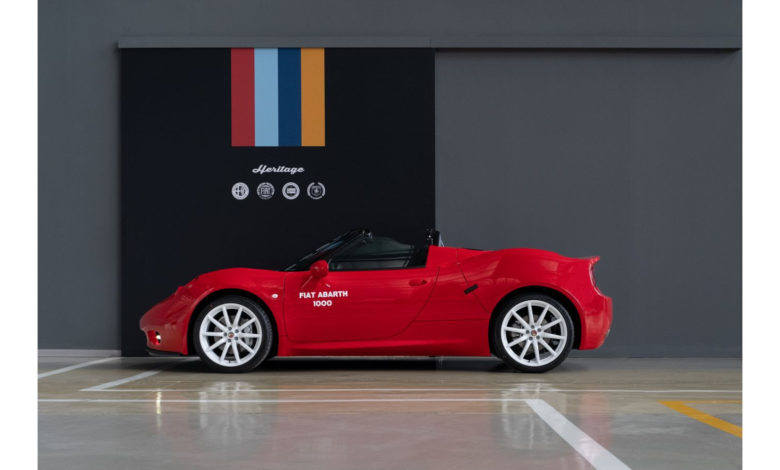
A surface area of 115,000 m2, 1,600 exhibitors, 130,000 visitors and over 5,000 cars for sale: these figures make the Padua “Auto e Moto d’Epoca” motor show (20-23 October 2022) one of the main vintage motoring events in Europe.
An essential inclusion on such a stage had to be the Stellantis Heritage department, founded in 2015 to protect the historical heritage of the Alfa Romeo, Fiat, Lancia and Abarth brands, and to convey the values of over 120 years of passion for cars. The department is therefore a standout at the event, with a fascinating stand featuring six vintage cars from different eras and brands.
Alongside these gems from the past, the Abarth Classiche 1000 SP is making its worldwide debut, its style model having been presented a year ago, again at Padua. Inspired by the 1966 Fiat Abarth 1000 Sport Prototipo, its historical forerunner, the Abarth Classiche 1000 SP is a rarity that will be produced solely to order, with a maximum of five specimens. It is also the first car ever only to show off one of the Classiche brands under the aegis of Heritage: further information on the sports car can be requested from our staff at the stand.
Padua has also been selected for the press and public presentation of the revamped Alfa Romeo Classiche certifications of authenticity, developed in close collaboration with the Biscione brand. This official recognition of the originality of the classic cars owned by private individuals is now issued by a certification committee made up of Alfa Romeo’s top management, brand experts and Heritage technicians. Proof is provided by the presence at the show of an Alfetta that has belonged to the same family, certified by the team. It remains in an exemplary original condition: the engine is the same as on day one, the car has never left the family garage of its first owner, and it maintains both its original colour and its interior. Alongside this classic car is the Alfa Romeo S.Z. sports car, restored by Heritage technical experts and now on display at the Mirafiori Heritage Hub.
The two Alfa Romeo models on display were selected for their close technical correlation: the Alfetta – celebrating its 50th anniversary this year – has a distinctive, sophisticated architecture based on the “transaxle” solution (gearbox, differential and clutch at the rear) combined with “De Dion” tube rear suspension. This car gave rise to a whole series of models, the final evolution of which can be seen in the 1989 S.Z.
A noteworthy fact: the Heritage Hub in Turin – where all the cars on show at the stand are kept, together with 300 others from the historical collection owned by the Stellantis Group – recently opened its doors for guided tours. Accessible via Gate 31 to the Mirafiori industrial complex – located at Via Plava 80, Turin – the spaces are hosting two guided tours per day on Wednesday, Friday and Saturday mornings and afternoons. Each one lasts around two hours. Tickets for these tours can be purchased online, here.
Last but not least, the space is also available to host cultural and corporate events for institutions and companies outside the Stellantis Group. For further information or to request a detailed quote, send an e-mail to the dedicated address, heritagehub@stellantis.com
Now, let’s have a look at the cars on show in detail:
Abarth Classiche 1000 SP (2022)
The Abarth Classiche 1000 SP is the contemporary reinterpretation of the 1966 Sport Prototipo, one of the milestones in Abarth’s competitive history. The original racecar became an icon of sportiness, as well as one of the House of the Scorpion’s most beloved models, for its style, performance, and winning track record – with victories all over Europe. It was a legendary car that inspired designers at the Centro Stile Fiat and Abarth, who designed its successor in 2009. In 2021, exactly 55 years since the launch of the historical model, the project was resumed by Abarth Classiche and was perfected to create a car that fully channels and modernises the personality of its glorious predecessor.
The Abarth Classiche 1000 SP echoes the lines and aesthetic elements that were a signature of the 1960s model. The car’s body – sinuous, with bold curvaceous mudguards that reinforce the visual impact of the wheels – echoes the layout of the central-engined spider. The geometries of the Abarth Classiche 1000 SP’s rear underline the perfect harmony between lights and exhaust system. The livery is strictly red and the characteristic air intakes appear all over, from the front bonnet to the cooling slots in its rear counterpart. The lights also respect the minimalist scheme of the historic 1000 SP, with point-like headlamps on the nose and a single pair of rear round taillights, to emphasise the car’s impressive width. The car is equipped with a gritty 1742-cc engine, capable of delivering 240 hp at 6000 rpm.
Abarth 1000 SP (1966)
The Fiat Abarth 1000 SP, in whose name “1000” indicates the displacement in cubic centimetres and “SP” the initials of Sport Prototipo – a light and powerful closed-wheel racing car with a two-seater spider body, was created in 1966 by the designer Mario Colucci. Equipped with steel tubular trellis chassis and central engine, the new 1000 SP was brought to the racetrack by the official Abarth team, and the excellent results obtained in prestigious competitions were the best advertisements to promote the vehicle to private customers.
The Sport Prototype was driven by the umpteenth evolution of the Abarth twin-cam engine built on the Fiat 600 base, and was designed to excel both in short uphill races and in long, hard endurance races. Its lightweight chassis and body in polyurethane and fibreglass held the 480-kg dry kerb weight of the vehicle, providing a maximum speed of over 220 km/h. Its simple, low, streamlined lines, especially at the front, were made possible by the placement of the radiator motor on the sides.
The first important sports success was achieved at the gruelling 500 km race on the Nürburgring track, on 4 September 1966: the Abarth 1000 SP, driven by Müller and Steinmetz, won the 1000 category outright and came third overall.
The echo of that victory again reverberated just a few days later in Valle d’Aosta, at the Aosta-Pila uphill race. Word of these two surprising successes began to get around and Abarth soon began receiving its first orders for the vehicle. After producing 50 cars, in March 1968 Abarth managed to obtain Group 4 Sport/Class 1000 homologation.
And the 1000 SP kept on racking up successes. Benefiting from numerous developments and transformations, the vehicle continued racing for over a decade, gratifying many gentleman drivers, some of whom would happily wait ages to receive the vehicles they had ordered from Abarth.
Abarth 750 Record (1956)
Presented at the 1956 Turin Motor Show, the 750 Record immediately stood out for its characteristic bodywork made by Bertone and designed by Franco Scaglione. Its profile was specifically defined to maximise aerodynamics, enveloping the driver’s seat, and ending with a large fin at the rear.
The overhanging rear engine was derived from the Fiat 600’s, souped up to 750 cc by Abarth. The standard suspensions and some mechanical parts were maintained, while the gearbox was modified to only three speeds, with a particularly long last one to meet performance needs. Despite a maximum power of merely 47 hp, its small size and shell mounted on a box-section sheet metal chassis weighing less than 390 kg made it possible for the 750 Record to accelerate to a top speed of over 190 km/h. This was the car that enabled Abarth, in June 1956, to set no less than six new records for Class H at the Monza racetrack: the 24-hour, 5000-km, 5000-mile, 10,000-km, 48-hour and 72-hour records, never dipping below an average speed of 140 km/h.
Alfa Romeo Alfetta (1974)
In 1967 Alfa Romeo started one of the fundamental projects for the fate of the company: the result of a constant quest for improvement and innovation, it was oriented towards the study of the car that would become the Alfetta (type “116”), tasked with raising the technical level of Alfa Romeo sports sedans even higher than their competitors’. This car was to be the epitome of technical evolution and of the successes achieved in the previous twenty years, first with the Giulietta and then with the Giulia.
The Alfetta – presented in May 1972 – proved an immediate success. The Argentine driver Juan Manuel Fangio, F1 World Champion in 1951 with the “159”, informally known as “Alfetta”, took part in the presentation: this circumstance is a significant example of how history and tradition have always played an important role among the corporate values of Alfa Romeo. The 1972 Alfetta sedan takes this name for its adoption of a technical solution – De Dion tube rear suspension, one of the main components of the car’s sophisticated mechanics, also found in the 1951 single-seater. Once again, the superiority of Alfa Romeo engineering was reiterated by the technical specifications of the Alfetta: equipped with a 1.8-cc engine, it could deliver 122 hp at 5500 rpm and could achieve a top speed of 180 km/h.
The 1972 Alfetta was produced at the Arese plant until 1984, with a total of 476,000 models made.
Alfa Romeo S.Z. (1989)
With only approximately 1000 units manufactured between late 1989 and 1991, the Alfa Romeo S.Z. (Sprint Zagato) is a pure-breed sports car with an unmistakable, assertive silhouette. Designed at the Zagato workshop, the Alfa Romeo S.Z. was practically assembled by hand in the coachbuilder’s factory just outside Milan. Mounted on a steel underbody, it features an exterior bodywork made of composite materials and derives its chassis and mechanical specs from the Alfa Romeo 75 race car, with the 3-litre V6 engine souped up to 207 horsepower for a top speed of 245 km/h.
The model on display is more than unique. It was one of the first ever made and is an “ex works” vehicle coming from the Balocco circuit, where it was used to experiment with different solutions. An authentic lab vehicle, it differs so much from later S.Z.s that it could be considered a prototype.
The car was completely disassembled and underwent careful restoration at the Heritage Officine Classiche workshop at Mirafiori: its body was stripped of paint and treated; the interior was completely regenerated, according to a conservative approach; the fuel tank was cleaned and suitably coated; the engine was carefully checked, with oils, filters and spark plugs replaced before an overall fine-tuning; the original wheel rims were meticulously cleaned to respect their originality, and all four tyres were replaced.
Lancia Aurelia B20 GT (1951)
Produced from 1951 to 1958, the unforgettable Lancia Aurelia B20 was an instant sales success that also excelled in Italian and international races.
The Lancia Aurelia B20 was presented at the Turin Motor Show on 2 April 1951 and heralded the introduction of an entirely new format, the Grand Touring 2-seater plus 2 (occasional) seats. Its outstanding 2000-cc engine – the first V6 in automobile history, created by the brilliant mind of designer Francesco De Virgilio – delivered 75 hp at 4500 rpm and enabled the car to achieve a top speed of 162 km/h. Such performance made the car a runaway commercial success despite its price tag of 2.6 million lire, a hefty sum in those days.
The race chosen for the new car’s debut was the 1951 Mille Miglia, in which Lancia entered four virtually mass-production B20 GT 2000s. The car driven by Bracco/Maglioli finished a very encouraging second overall behind Villoresi’s Ferrari 4500. This excellent performance was reasserted by the good finishes of the other three cars, in fifth, seventh and seventeenth places. In June 1951, Bracco’s B20 won its class and finished twelfth overall in the 24 Hours of Le Mans. Also in 1951, B20 cars won the Pescara “6 Hours” and the Coppa d’oro delle Dolomiti. The two-litre B20 repeated its racing success at the Mille Miglia the following year, with a third placing overall and four cars finishing in the first ten: wonderful publicity, especially in view of how little was spent on preparation of the cars. This earned the Aurelia the fame of a production car, which was so efficient and safe that it could even be successfully used in races.
To this day, the Lancia Aurelia B20 remains a Grand Tourer par excellence that has retained its classic and timeless appeal. The car on show – a supremely elegant model where black bodywork is combined with interior upholstery in grey Lancia cloth – is one of 500 first-series Aurelia cars that were produced in 1951.
Lancia Delta HF Integrale (1994)
The car on show never left the company and has only a few dozen kilometres on the clock. It belongs to the fifth and last series of the Delta HF Integrale (known as the “Evo 2”). The final development of the four-wheel drive Delta (a car that would enter rally legend with its six World Championship wins in row from 1987 to 1992), the car had boosted suspensions and brakes and a beefed-up four-cylinder two-litre turbo delivering up to 215 hp, powering the Delta to reach a top speed of 220 km/h.
It is worth a final mention that, on display alongside the glorious sports car – embodying the brand’s timeless elegance, just like the Aurelia B20 – are the bumpers and sheet metal produced specially for the Delta Integrale, made by Heritage and Mopar and available for purchase by collectors.


